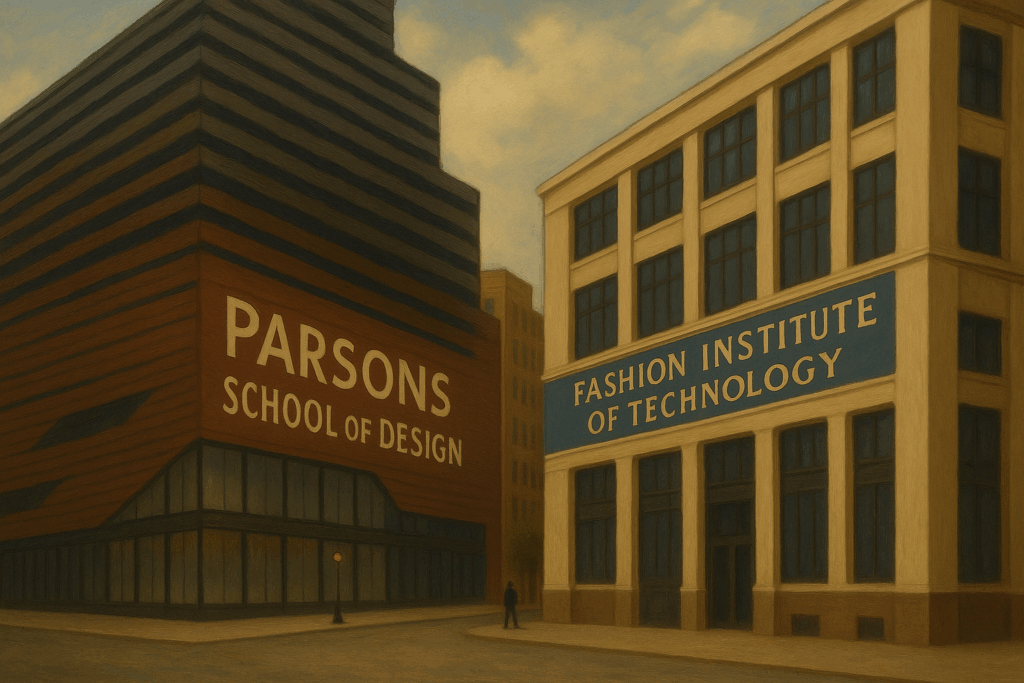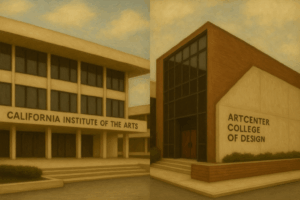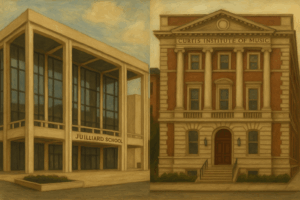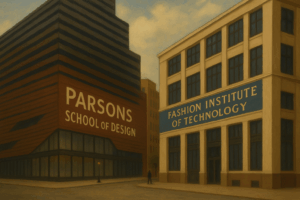
The GOAT of American Fashion Schools?
New York, the city where the heart of global fashion beats. At the center of this city are two colossal names that bisect the fashion world: Parsons School of Design and the Fashion Institute of Technology (FIT). The choice between these two schools is more than just selecting a university; it is the beginning of a momentous journey to define your design philosophy and identity.
This article, based on the latest 2025 information, aims to delve deep into their souls, moving beyond a superficial comparison. While one sees fashion as a ‘critical tool’ for social change, the other concentrates on cultivating the ‘best professionals’ to lead the industry. Are you an ‘explorer’ who wants to create your own artistic language? Or are you an ‘artisan’ who wants to stand at the pinnacle of the industry? This article is an in-depth guide to the most important choice for your future.
1. Educational Philosophies: The Critical Innovator vs. The Industry Leader
Parsons School of Design: The Critical Thinker Who Designs Society
Parsons’ educational philosophy views fashion as a powerful medium to critique society, ask questions, and lead positive change.
The educational goal at Parsons is to nurture designers who can not only create beautiful clothes but can also empower marginalized communities and trigger systemic social change through the tool of fashion.
This philosophy permeates the entire curriculum, preparing graduates to perform a broader range of roles beyond that of a pure designer, such as researchers, strategists, and curators.
Fashion Institute of Technology (FIT): The Professional with Creativity and Commercial Savvy
FIT aims to cultivate talent that is balanced with a creative vision and the technical and business competencies necessary to succeed immediately in the commercial fashion industry.
FIT’s education can be summarized as providing a “rare blend of hands-on, real-world experience, theory, and a firm grounding in the liberal arts.” The ‘innovation’ that FIT pursues is not abstract; it is commercial and technological innovation that moves the market, based on deep industry knowledge and technical mastery.
2. The BFA Curricula: Conceptual ‘Pathways’ vs. Specialized ‘Concentrations’
The Parsons BFA: Self-Directed Exploration Through Four ‘Pathways’
Parsons encourages students to engage in broad, interdisciplinary thinking before specializing in a specific field. Starting in their sophomore year, students choose one of four conceptual ‘Pathways’ based on their interests and philosophy.
- Collection: Developing new aesthetic narratives that challenge traditional concepts.
- Materiality: Focusing on material and textile innovation.
- Fashion Product: Developing a new range of products by connecting fashion with lifestyle and technology.
- Systems & Society: Critically exploring the connection between fashion and contemporary social issues.
The FIT BFA: Industry-Tailored Specialization Through Five ‘Concentrations’
FIT takes a skills-first, specialization-second approach. Students first learn essential skills in a two-year AAS (Associate in Applied Science) program before choosing a highly specialized concentration in the BFA program. This system directly mirrors the departmental structure of the fashion industry.
- Sportswear
- Knitwear
- Intimate Apparel
- Special Occasion
- Children’s Wear
3. Graduate Programs and Facilities: Spaces to Explore Fashion’s Future and Past
Parsons: The Conceptual MFA and the Integrated Making Center
Parsons’ MFA (Master of Fine Arts) program is akin to a ‘think tank’ for the future of fashion. It is a program for designers who want to understand and influence the ‘why’ and ‘how’ of the entire fashion system. Supporting this is the ‘Making Center,’ a ‘super lab’ equipped with a wide range of tools like 3D printers and laser cutters, which physically supports the philosophy of interdisciplinary fusion.
FIT: The Academic MA and a Living Museum
FIT’s MA (Master of Arts) program focuses on ‘history, theory, and museum practice,’ nurturing scholars and guardians of fashion history. Its key asset is the world-class ‘The Museum at FIT.’
- ‘The Museum at FIT’ is a museum housing over 50,00_ garments and accessories, and it’s more than just an exhibition space—it’s a ‘living learning resource.’ The physical and tactile understanding gained from directly handling and studying the works of masters like Balenciaga, Chanel, and Dior is an invaluable experience that can never be obtained from books alone.
4. A Comparison of Alumni: 20 Masters Who Move the Fashion World
A Glance at Key Alumni from Parsons vs. FIT
| School | Designer’s Name | Signature Style & Contribution |
|---|---|---|
| Parsons | Tom Ford | Sensual glamour, a perfectionist’s total look. |
| Donna Karan | The ‘Seven Easy Pieces’ for the modern working woman. | |
| Marc Jacobs | Grunge style, artistic wit, and a rebellious spirit. | |
| Alexander Wang | Urban streetwear luxury, the aesthetics of black. | |
| Proenza Schouler | Intellectual modernism combined with art and craft. | |
| FIT | Calvin Klein | The master of minimalism and provocative marketing. |
| Michael Kors | The builder of an ‘accessible luxury’ empire. | |
| Norma Kamali | Futuristic innovation, inventor of the ‘sleeping bag coat’. | |
| Carolina Herrera | Timeless elegance, the designer for First Ladies. | |
| Reem Acra | Exquisite and glamorous bridal and eveningwear. |
10 Innovators Produced by Parsons
- Tom Ford: Based on his background in architecture, he creates a complete ‘total look’ and worldview that encompasses not just clothes but advertising, stores, and even film.
- Donna Karan: She presented a design solution to the ‘problem’ faced by busy modern working women with her “Seven Easy Pieces” concept.
- Marc Jacobs: With his legendary ‘Grunge Collection,’ he showed the Parsons spirit that values creative and rebellious self-expression over commercial success.
- Alexander Wang: He pioneered a new genre of ‘urban luxe’ by blurring the lines between luxury and streetwear.
- Proenza Schouler: They create intellectual and sophisticated womenswear, drawing deep inspiration from modern art and craft.
- Jason Wu: The master of exquisite detail and sophisticated femininity who gained global fame for designing Michelle Obama’s inaugural gown.
- Anna Sui: She fuses her own romantic style based on vintage styles and extensive research into various cultures.
- Derek Lam: With ‘calculated simplicity’ and ‘intellectual sophistication,’ he eschews unnecessary decoration to focus on structure and material.
- Jenna Lyons: While leading J.Crew, she popularized the ‘high-low’ style of mixing high fashion with basics.
- Prabal Gurung: A designer who infuses his cultural heritage into his designs while also using fashion as a tool for social commentary.
10 Titans Produced by FIT
- Calvin Klein: A business genius who combined minimalist aesthetics with provocative marketing to turn jeans and underwear into ‘objects of desire.’
- Michael Kors: He pioneered the ‘accessible luxury’ market and built a multi-billion dollar global empire.
- Norma Kamali: An innovator who opened up new possibilities in fashion by combining technology and practicality, with inventions like the ‘sleeping bag coat’ and ready-to-wear made from sweatshirt material.
- Carolina Herrera: The epitome of ‘timeless elegance,’ a designer beloved by numerous First Ladies.
- Reem Acra: A master of exquisite detail and glamour who has built one of the top luxury brands in the bridal market.
- Nanette Lepore: The success story of an independent brand that gained great popularity in department stores and boutiques with its feminine and youthful designs.
- David Chu: He founded the global lifestyle brand ‘Nautica’ with the clear concept of ‘sailing.’
- Francisco Costa: As the creative director of Calvin Klein, he successfully reinterpreted the brand’s minimalist heritage.
- Brian Atwood: An expert in a specific product category who successfully launched his own brand in the luxury shoe market.
- Stephen Burrows: A master of vibrant color and unique finishing techniques who was a sensation during the 1970s disco era.
Final Conclusion: Which Art School Fits Your Artistic DNA?
There is no ‘better school.’ There is only the school that is a ‘better fit for you.’
When You Should Choose Parsons
If you want to use fashion to make your voice heard in the world, if you want to question existing aesthetic standards, and if you want your graduate collection to be a manifesto, then Parsons will be the stage where you can fully unleash your intellectual curiosity and creative rebelliousness.
When You Should Choose FIT
If you feel exhilaration from a perfectly crafted garment made with the best technique, if you dream of your designs growing into a massive business, and if you want to master the complex system of the fashion industry to stand at its summit, then FIT will be the most solid and practical launchpad to realize your ambitions.
The fashion world needs both the sharp critics who change the world and the powerful builders who move the industry. What makes your heart beat faster? Choose the school that resonates most deeply with your unique voice, passion, and vision for the future. That is where your story will begin.


